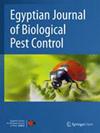Efficacy of Bacillus licheniformis: a biocontrol agent against Colletotrichum gloeosporioides Penz. (Penz. & Sacc.) causing anthracnose in greater yam (Dioscorea alata L.)
IF 2.1
3区 农林科学
Q1 ENTOMOLOGY
引用次数: 0
Abstract
Abstract Background Anthracnose, caused by Colletotrichum gloeosporioides, is the most dangerous fungal disease of greater yam ( Dioscorea alata L.), and leads to significant crop loss. Microbial technology in cropping systems is currently focused on biological control agents (BCAs), which include plant endophytes like bacteria, which contribute well to sustainable production. In the present study, the ability of an endophytic bacterium, Bacillus licheniformis (CTCRI EB12), isolated from Aloe vera was investigated to prevent the disease. Results The bacterium, CTCRI EB12, was characterized as a member of the Bacillus genus by morphological and biochemical tests and confirmed as B. licheniformis via 16S ribosomal gene analysis. The effectiveness of the endophytic bacterium was affirmed through cell confrontation assays and scanning electron microscopy. In cell confrontation assay, the isolate inhibited all the three C. gloeosporioides isolates used in the study with more than 80% inhibition. The effect of culture filtrate of the isolate was also tested against pathogens that were compliant with the outcome of dual culture technique. The culture and culture filtrate could effectively restrain the spreading of C. gloeosporioides in greater yam leaf. The isolate could completely inhibit the growth of the pathogen through an antibiosis study, and the same could be explained through scanning electron microscopy results, in which the endophyte-treated C. gloeosporioides hyphae appeared longer and distorted compared to control and conidia possess disfigurement in endophyte-treated sample when compared to control. Conclusions The study showed that Bacillus licheniformis (CTCRI EB12), the endophytic bacterium that has the capacity to enhance the protection of greater yam plants, could be further developed as a microbial pesticide to reduce the effect of anthracnose in greater yam fields. Additional investigation will reveal the endophytic isolate's antifungal capabilities and assessment of their performance in the open field. The present study depicted that it might be a potent biological control agent against C. gloeosporioides causing greater yam anthracnose.地衣芽孢杆菌对炭疽病菌的防效研究。(Penz。,在大山药(薯蓣)中引起炭疽病。
摘要背景炭疽病是薯蓣(Dioscorea alata L.)最危险的真菌病害,由炭疽菌(Colletotrichum gloeosporioides)引起,造成重大的作物损失。种植系统中的微生物技术目前主要集中在生物防治剂(bca)上,其中包括植物内生菌,如细菌,它们对可持续生产有很大贡献。在本研究中,研究了从芦荟中分离的内生细菌地衣芽孢杆菌(CTCRI EB12)预防该病的能力。结果CTCRI EB12经形态学和生化鉴定属于芽孢杆菌属,经16S核糖体基因鉴定为地衣芽孢杆菌。通过细胞对抗试验和扫描电镜观察证实了该内生细菌的有效性。在细胞对抗实验中,该分离物对3株gloeosporioides均有抑制作用,抑制率达80%以上。并对培养滤液对符合双重培养结果的病原菌进行了抑菌效果试验。培养液和培养滤液均能有效抑制山药大叶线虫的蔓延。通过抗生素研究,分离物可以完全抑制病原菌的生长,扫描电镜结果也可以解释这一点,在内生菌处理的样品中,gloeosporioides菌丝比对照更长、扭曲,分生孢子比对照有缺陷。结论地衣芽孢杆菌(Bacillus licheniformis, CTCRI EB12)是一种具有增强山药保护作用的内生细菌,可以作为微生物农药进一步开发,降低山药田炭疽病的危害。进一步的调查将揭示内生分离物的抗真菌能力和评估其在野外的表现。本研究表明它可能是一种有效的防治山药炭疽病的生物防治剂。
本文章由计算机程序翻译,如有差异,请以英文原文为准。
求助全文
约1分钟内获得全文
求助全文
来源期刊
CiteScore
4.90
自引率
16.70%
发文量
128
审稿时长
>12 weeks
期刊介绍:
The Egyptian Journal of Biological Pest Control is a periodic scientific journal published by the Egyptian Society for Biological Control of Pests (ESBCP) in collaboration with SpringerNature. The journal aims to publish internationally peer-reviewed, high-quality research articles in the field of biological and integrated pest control (non-chemical control). The journal publishes review articles, original papers, conference reports, book reviews, editorials, laboratory reports, technical notes and short communications.

 求助内容:
求助内容: 应助结果提醒方式:
应助结果提醒方式:


